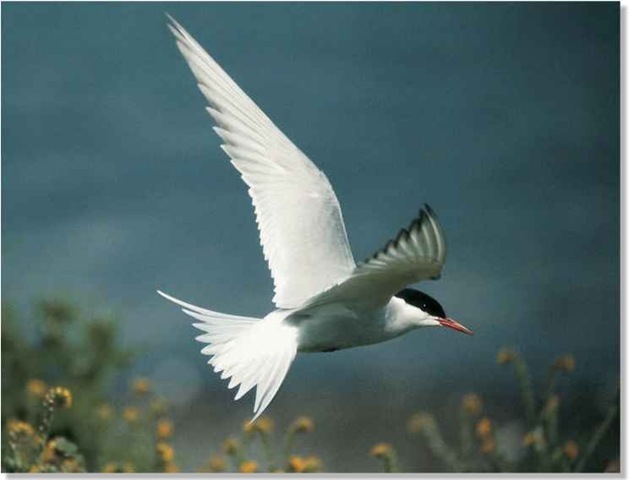ORDER
Charadriiformes
FAMILY
Laridae
GENUS & SPECIES
KEY FEATURES
Elegant and agile bird with great stamina Migrates farther than any other animal Follows the sun through the seasons; in a year experiences more daylight than any other animal in its lifetime, may fly farther than the total distance to the moon and back
WHERE IN THE WORLD?
Breeds in the far north of Canada, Asia and Europe; spends the rest of the year in the southern Pacific and Atlantic, chiefly on Antarctic pack ice

Lifecycle
Life is a long summer for the Arctic tern, but its globe-trotting migrations are hard work. Each annual round trip may involve crossing vast oceans and total up to 24,000 miles.
HABITAT
The Arctic tern breeds within latitudes from Massachusetts and Brittany, France, north to within 420 miles of the North Pole, at sites such as the northern tip of Greenland.
During the summer breeding season, long hours of sunlight give the bird plenty of time to catch food.The tern nests mainly on coasts or offshore islands, flying short distances out to sea to catch fish for itself, its mate and chicks. In Scandinavia and Canada, the Arctic tern sometimes follows rivers far inland, nesting up to 180 miles from the sea and feeding on fish in the lakes and rivers.
After breeding and rearing its chicks, the Arctic tern spends the rest of the year at sea, flying a vast distance south to spend the southern summer (the northern winter) mainly around Antarctica. There, the tern rests on icebergs or floating pack ice.

Beach babies The summer breeding grounds for the Arctic tern extend as far south as the sandy shores of Massachusett coasts.
Tern to the north The world’s most northerly landmasses are home to the tern during summer in the northern hemisphere.

BEHAVIOR
Terns nest in noisy colonies (often several thousand pairs) and feed in flocks of ten to several hundred birds. It’s best known for epic journeys from northern breeding grounds to the southern oceans, returning the next year to breed. In its lifetime, an Arctic tern may travel at least 480,000 miles.
The tern migrates alone or in small groups. It usually flies down the west coast of North America, then follows the east coast of South America or crosses the Atlantic before continuing south. Eurasian birds follow the Atlantic coasts of Europe and Africa. With wind directions, these routes are the quickest and easiest for terns.
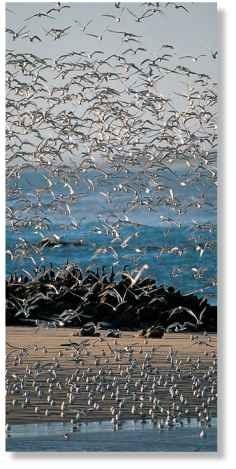
FOOD & FEEDING
Fish, crustaceans and insects are the main food of the tern, but prey varies with location. Shrimp, crabs, migrating insects and small squid are taken in flight from the surface waters; the tern also snaps up flies and moths at its breeding grounds.
The tern catches fish by diving into the sea, although it rarely dives deeper than 24″ and may be under the waves for no longer than a second.The tern holds fish crosswise in its sharp-edged bill and can catch one or two more fish while still carrying the first. Herring, haddock, sprats, butterfish and even small salmon are typical prey, but sand eels are especially important at breeding time, providing a nutritious and convenient-sized meal for chicks.
WORLDS APART

1 Northern colonies
The tern spends the summer at its northern breeding colonies. The young will be ready to migrate after about three months.

2 About tern
In late summer, terns set off for the great journey south. Adult pairs often travel apart, reuniting the following breeding season.
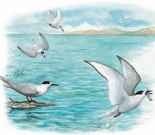
3 Low-level refueling
Heading south along their flyways, terns swoop to snatch fish from the sea. They stop occasionally to rest on driftwood, buoys and coasts.
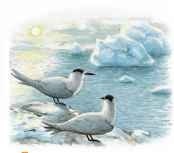
4 Long, cool summer
Terns take four months to complete the journey to their southern winter quarters. By next April, they’ll return.
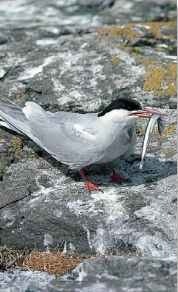
A Eel meal
Sand eels are an important source of food during the tern’s breeding season.
The tern defends its nesting colony fiercely: it’ll swoop to attack predators or humans and may draw blood with its sharp bill.
The tern sometimes nests close to gull colonies. Although the gulls steal a few eggs and chicks, they protect terns from predators, such as foxes. Similarly, phalaropes and oldsquaw ducks often nest near terns, relying on the terns’ sharp eyesight to warn them of danger.
CONSERVATION
The tern’s population is currently stable. But it’s threatened by overfishing, resulting in a lack of food for chicks. In 1989, 10,000 breeding pairs on the Shetland Isles, off Scotland, reared just 100 young.The year after local sand eel fishery was banned, 30,000 chicks were reared in the same colonies.
BREEDING

A Friends again Adult terns mate after renewing their pair bond.
Terns pair for life. When adults return to their old nest site in spring, they renew their bond with courtship flights.The male brings food to his mate to help her into peak breeding condition.
The female lays one to three eggs in a scrape in sand or gravel. Both parents incubate the eggs and bring food to the young when they hatch in three weeks.Young stay in the nest for two or three days, then leave to hide in groundcover.They can fly in three to four more weeks, but parents may feed them for another two months.
Profile
Arctic Tern
The Arctic tern’s streamlined form allows it to dive for fish with masterful agility and minimizes drag during its long migrations.
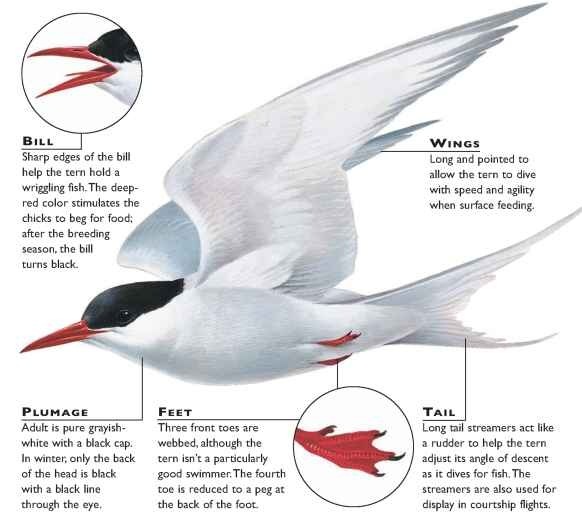
CREATURE COMPARISONS
A few subtle features distinguish the Arctic tern common tern, Sterna hirundo, has a black tip
from other members of its family with which it on its bright red bill during the breeding season.
shares parts of its range.The Arctic tern’s bill is Much larger than the other two birds, the royal
a deep blood-red during the breeding season tern has a ragged black crest and a bright
and black for the rest of the year; whereas the yellow-orange bill.

| VITAL STATISTICS Weight 3.5-4 oz. |
|
| : Length | 13-14″ |
| Wingspan | 30-34″ |
| Sexual Maturity | 2-5 years, usually 4 |
| Breeding : Season | May-August |
| | Number | of Eggs | 1-3 |
| F Incubation | Period | 20-24 days |
| Breeding Interval | 1 year |
| ‘ Typical Diet | Marine fish, crustaceans, small squid, insects |
| Lifespan | Up to 34 years |
RELATED SPECIES
• There are 43 species of tern in the Laridae family. These include the common tern, Sterna hirundo, of Europe, Asia and North America. The Antarctic tern, S. vittata (slightly larger than the Arctic tern), was once thought to be descended from Arctic terns that stopped migrating and stayed to breed on islands close to the Antarctic Circle, but today the two birds are recognized as separate species.
